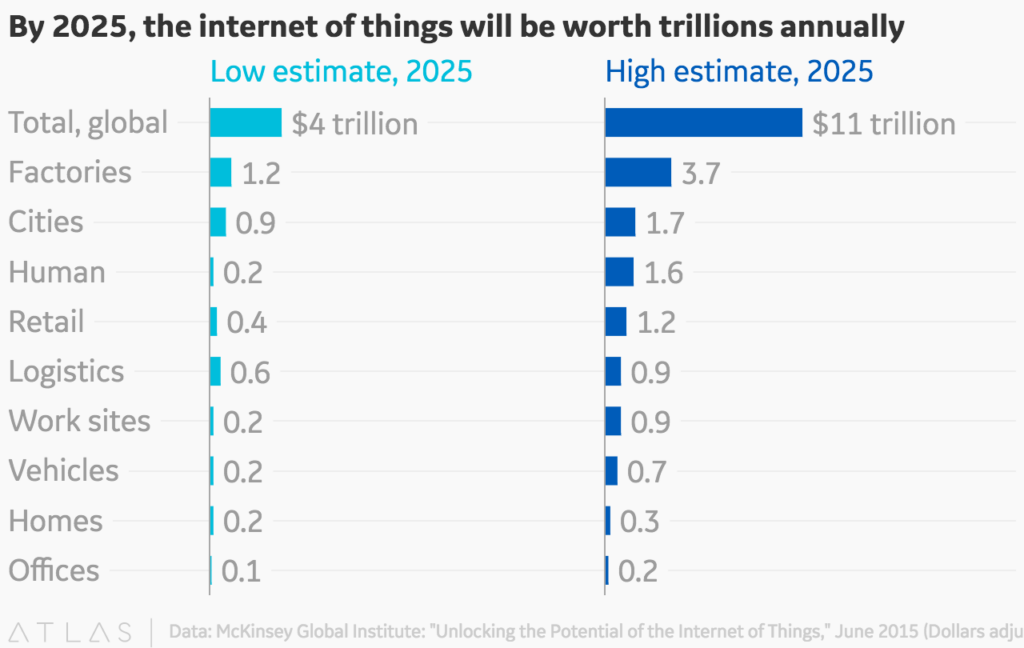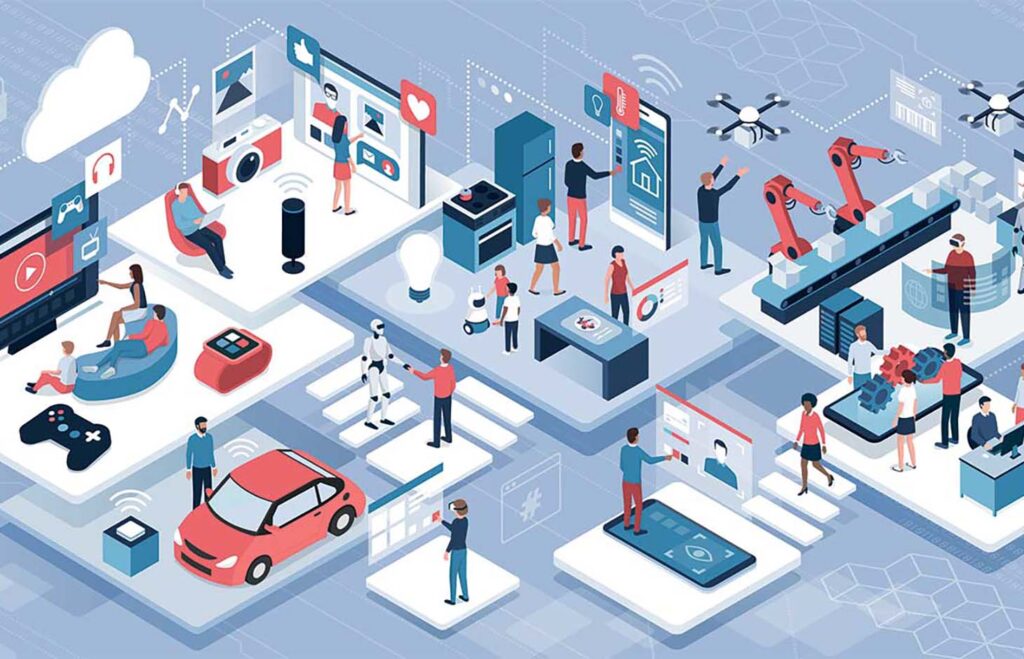Our world is increasingly interconnected through technology, speeding up the delivery of products and expanding safety and security. A variety of connected devices are bringing conveniences to us at an ever-growing pace.
These devices collect and analyze data to explore ways to increase efficiency and usability, and their number is growing exponentially. According to one report, IoT (Internet of Things) devices are expected to hit 20.4 billion in 2020, up from 8.4 billion only a few years ago. International Data Corporation (IDC) is forecasting IoT spending on connectivity to hit $83 billion this year with the CAGR (Compound Annual Growth Rate) estimated at 16.6% over the next five years.
With some estimates suggesting IoT will be worth between $4 and $11 trillion globally by 2025, the impact of this industry is truly set to explode.

There are a number of ways devices can be deployed to end users, whether on a personal level or with a large enterprise. Devices can be sold directly through the manufacturer; however there is a growing trend to market and sell through third-party businesses who add their own services.
In this expanded IoT ecosystem of vendors, resellers, and end users, how does a manufacturer keep track of which IoT device is provided through each channel? More importantly, how does that manufacturer juggle monetization with customer management and billing on a recurring basis at scale?
Adapting the recurring billing model for the reseller
Let’s try to understand the IoT ecosystem that’s in play in today’s business landscape. There are three major parties involved in selling and reselling IoT devices:
- The vendor or manufacturer who creates the device.
- The reseller or distributor who markets or sells the device.
- The end user who purchases or uses the device.
If a manufacturer sells directly to the end user, the process is simplified. The business can deploy a recurring billing platform and automate billing on an ongoing basis, just as in any other subscription management process.
However, when a reseller or distributor enters the picture, the sales model becomes more complex. When working with a third party, there can be any number of distributors involved in different territories.
For example, networking enterprise business Cisco had more than 60,000 ‘channel partners’, or resellers, in 2016.
Consequently, additional layers of management come into play. The challenge is in allowing these accounts to intertwine while operating under the same umbrella. This results in several connected, but unique pathways which must be accounted for to determine:
- who pays the bill?
- who receives the invoice(s)? and
- who controls any changes in these relationships?
Answers to the above three questions typically dictate which billing strategy should be implemented.
Challenges of working with resellers in the IoT space
Without an agile monetization or billing platform, it can be difficult for an IoT manufacturer to track which accounts are tied to which reseller. There are several additional questions that come into play.
- Do they need to be making additional agreements in other regions?
- Do they need to be reworking their pricing structure?
- Are their current relationships with resellers profitable?
A complete and modern billing platform can efficiently report on those questions.
Comprehensive device data drives billing systems, but if you can’t access that data quickly, valuable time is wasted. Data powers decisions, and an agile billing platform supports IoT manufacturers with the granular data required to be effective and profitable.
The data includes answers to questions such as:
- where are sales coming from?
- what are the margins with certain customers?
- which reseller is outperforming the others? and
- is there a different approach to servicing distribution for one region versus another?
Seamless scaling with IoT device distributors
Many businesses face yet another layer of complexity when they achieve rapid growth and start to scale.
Without a flexible subscription management and recurring billing platform, it can be cost-prohibitive to add resellers and distributors. Lacking back-end support, IoT manufacturers are introducing more complexities and additional overhead that their business needs to manage. The increase in such costs must be offset by the revenue those resellers and distributors bring back to the bottom line.
However, with an agile recurring billing software, growing your business by adding distributors is straightforward. For a comprehensive billing platform, they’re just new customers added into the ‘Rolodex’.
From a roll-out standpoint, adding resellers should be seamless; ideally, adding resellers when the opportunity presents itself is quick and easy. This flexibility encourages suppliers and manufacturers to grow quickly to accommodate ever-increasing sales. It may only be adding X number of new resellers from a cascading standpoint, but if each distributor brings an increase in end users, the business stands to achieve maximum growth velocity.
Not just IoT: Many industries can leverage the distributor model
Is this model for everybody? Probably not. But some industries have tapped into recurring billing opportunities and are primed for growth under the manufacturer/supplier-distributor-end user relationship.
A great example of a software as a service (SaaS) company finding success through resellers is with Xero, an accounting software provider.
In 2009, Xero had 12,000 customers. Then, it started to employ different sales strategies, including adding resellers to its lineup. Within three years, Xero had 135,000 customers with 60% coming in through its reseller program.
In the IoT space, there are individual sectors experiencing exponential growth in the distributor business model.
1. IoT providers
IoT devices, in simple terms, are objects with a ‘brain’ to collect data and provide value. For example, a lightbulb connected to a ‘hub’ in a smart home that can turn on or off with voice commands. Or a sensor on a smart home network sending information to the home security provider.
Similarly, IoT devices in the enterprise world can connect to sensors to collect critical data. The IoT sector is positioned to grow exponentially. According to one estimate, half of the estimated 28.5 billion IoT devices in 2022 will consist of machine to machine, or M2M, connections.
Imagine how many M2M connections will be utilized in 2030, when as per estimates 500 billion devices will be ‘animated’ and tapped into the internet.
There are also situations where a business may provide IoT devices and services directly to end users, whether they are B2B or B2C customers. There can even be situations where one overarching manufacturer of devices has a slew of resellers repackaging that original equipment manufacturer (OEM) product while wrapping their own recurring subscriptions around it.
2. Telematics
Within the IoT umbrella are several spin-off industries, including telematic and managed service provider (MSP) businesses.
Telematic organizations offering GPS services with track-and-trace business have hardware they’re selling with additional services. They might also be providing insurance, location notifications, and remote monitoring for industrial equipment.
Stax Bill has a native integration with major telematics player Geotab, which was recently awarded the world’s largest telematics contract. Geotab has hundreds of resellers that package its GPS devices and sell them into various markets, while adding its own recurring services to them.
3. Value added resellers
Value added resellers (VARs) are distributors that make a profit via markup on the device itself and its base monthly fee. They also envelop that device with their own specialized services. In other words, they have the service portion of a great device/feature combination without the need to have manufacturing arms and deliverables to create the hardware.
In this scenario, the resellers are making money on the services and monitoring they provide.
4. Managed service provider (MSP) businesses
Another use-case scenario includes MSPs. For example, consider an IT MSP that’s monitoring network devices for a bank. It might be using its own proprietary services, or it might be reselling an existing set of hardware, such as Amazon servers. The MSP hasn’t manufactured that hardware, but is packaging it to create value-add and generate revenue from the services its deriving around it.
In the MSP, telematics, and IoT worlds, much revenue can be derived from partnerships around distributors, resellers, and OEM products.
Without an agile IoT billing system, managing these different aspects to leverage monetization opportunities is extremely difficult.
How a robust billing platform complements distribution opportunities
In all these different scenarios, it’s important to determine who’ll be footing the bill—the distributor or the end user? The differences in billing use-cases typically direct which model is best.
1. The manufacturer may be billing the reseller directly. A billing platform may be merely tracking who its customers are for reporting’s sake. Or, the reseller may be a pass-through entity, where the end user is paying for the product themselves.
2. In another scenario, the end user exists as a subscription on the seller’s account. The distributor is getting rolled-up information every month while the subscription activity is with the end user. Each line item, or each subscription, represents an end user organization.
Granular billing information is required by many resellers. They need visibility at the single user level, but they’re still under the umbrella of the manufacturer—the primary contact in the recurring billing platform.
Essentially, the end user is billed on behalf of the manufacturer or supplier, but the distributor is given tangible insights through additional reporting and visibility to determine where sales are coming from.
3. If the end user is paying for the product or service directly in a B2C scenario, that may require a different strategy. The billing platform employs a parent/child relationship in that case. The overarching company is the ‘parent’ and the end user is the ‘child’.
The parent/child relationship is also a good model if the end user is the one making payments, because that end user can receive their own invoices and access their self service portal (SSP). Furthermore, if that end user ever branches off from the existing model and begins working directly with the supplier, there can be a smooth transition from one model to another.
4. There’s also the possibility of a hybrid billing scenario, where the manufacturer/supplier sells directly to some end users, while also working through distributors.
As you can see, different scenarios warrant different billing management strategies. Rolling out the right model can ensure successful manufacturers and resellers, and happy end users.
Even if a billing model was historically successful, there are always market forces that necessitate adaptation. A legacy billing model doesn’t necessarily have to remain the same moving forward.
An agile recurring billing platform like Stax Bill prevents a supplier from being tied to one specific billing model. Instead, the billing process can be adjusted as needed. This flexibility provides a compelling business advantage for both the supplier and the reseller.
Adding value to your IoT partnership ecosystem with agile monetization
Consumer mindset has shifted over the last several years as e-commerce has flourished. It’s now critical that businesses align billing methods with customers’ expectations and perceived value.
Offering the end user flexibility, with out-of-the-box, easy to use, accessible tools to manage their own subscriptions closes the circle on customer experience.
There’s additional value in a manufacturer with a flexible billing platform that enable the manufacturer to put reseller logos and addresses on invoices. The end user receives a bill from the reseller they’re working with, sent by the manufacturer. This is streamlined, automated billing at its best. The process helps to align perceived value for the end user with that of resellers or distributors. In turn, the resellers also see the value of aligning with the overarching organization: the manufacturer.
This is an effective tactic to incorporate—three different parties on a single transaction/payment stream, with the transaction presented in a way that makes sense for everyone involved. All this is done while providing ample reporting access, both for the reseller and the manufacturer.
Everybody gains necessary visibility into the ecosystem’s performance with appropriately segmented reports. From there, it’s simply a matter of fine-tuning deliverables and optimizing services to accelerate growth.
The reseller model works well for IoT businesses as well as those in the MSP and telematics sectors. With appropriate billing support, a business can combine one partner’s hardware and another’s services to create a cohesive relationship.
Selling through resellers and distributors can create challenges without proper support. A proven billing platform can provide the necessary flexibility to manage a variety of selling pathways. Organizations that are similarly empowered don’t have to worry about billing complexities with a ‘set-it-and-forget-it’ format. Growing pains are all taken care of when the billing platform is:
- handling all scalability efforts
- providing superlative user-experience for end users
- delivering superior support for resellers, and
- optimizing the supplier experience with reporting and insights as they grow their business.
Flexible billing solutions streamline the monetization process
Regardless of how a business decides to work with distributors and end users, the ability to manage these relationships seamlessly is critical.
With a modern billing platform, a supplier/manufacturer doesn’t need to reinvent the wheel to add distributors. The manufacturer easily adds another revenue-driving channel into its business.
An agile IoT billing platform can help you create multiple architectural paths for deployment.
- The path where you deliver to end users directly.
- The path where you deliver to the end user through a reseller or distributor.
Being able to streamline both avenues with a single robust monetization process is invaluable.
In essence, the manufacturer is leveraging the basic functionality of the billing toolset. This functionality includes flexibility in how information is conveyed to a reseller, which could differ from how it is supplied to the end user.
As a business grows, it uncovers additional partnerships and potential models. Depending on the agility of its billing processes, the business prospers.
With a flexible billing platform, it’s just a matter of leveraging the best billing model for your business.
At Stax Bill, our team has streamlined the onboarding process. IoT businesses don’t find much data grooming necessary to use our platform when working with resellers. Whether someone is selling OEM products for a provider or allowing another organization to sell their products through portals, the deliverables are the same.
An agile billing solution empowers an IoT business’s ecosystem to rapidly deploy effective go-to-market strategies, be more profitable, and secure a quick return on investment.








